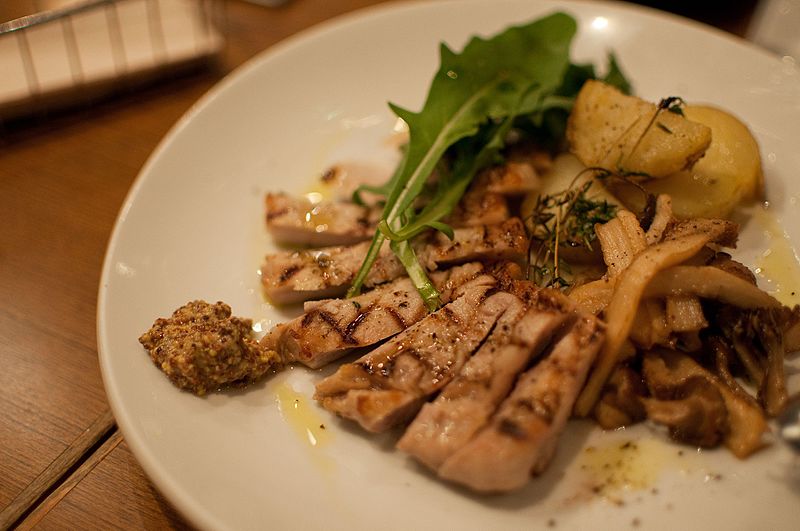Downloads:

Braising
Sauté
Keywords
Food elaboration techniques, traditional cooking, braising, sauteing, healthy food, meat, vegetables, fish
Level

Braising
BRAISING
Braising is a technique of French origin that consists in cooking food with very little amount of liquid. This is a long-duration technique as it requires the food to be simmered in its own juice. This technique is mainly used to cook large pieces of meat, which can be cooked with some vegetables.
Braising mixes dry-heat and moist-heat cooking, and therefore it is considered a mixed cooking technique. To apply it, we must sear the meat first in a shallow pot (oven-proof), just the surface, with a small amount of very hot oil. When the meat is brown on the outside (but not cooked on the inside), we add the vegetables cut in small pieces (i. e. carrot, leek, celery, onion) in the same pot and stir it a bit so that they take the juice of the meat (dry heat).
Then, after adding the liquid, the pot must be covered and put in the oven at a temperature between 150° and 170° for a slow cooking. Enough liquid, which can be broth, wine, beer, etc., must be added, in order to cover the meat so it can be cooked inside the liquid, and also with the steam created with the pot covered (moist heat). When it starts boiling, the liquid evaporates and reduces, so the meat ends up uncovered. We will have to water the meat often and turn it over so it does not dry and is cooked homogenously in all its sides. This very technique can be cooked over a slow heat on the stove.
The cooking time will depend on the type and toughness of the meat. To check that the meat is ready, it must be pricked carefully.
Sauté
SAUTÉ
This technique is usually associated with frying, but to fry, much more fat (oil or butter) and cooking time is required.
Sautéing is a cooking technique widely used in Oriental cuisine (wok), which consists in cooking food on a high heat for a short time and with a small amount of fat. The interesting fact about this technique is that, during that time, the food has to be continuously moved and “jump” in the frying pan, so that it can be cooked homogeneously and thus avoid burning.
Important things to be considered:
- For sautéing you need a big frying pan where you can add all the food in one layer, without overlapping.
- The food must be cut into tiny slices and more or less evenly.
- Usually, we will not need more than 5 minutes to cook the food, so the temperature of the heat should be between 175°-225° C. If some food it tougher than other, we sauté this first and then add the rest.
- And…the magic touch: food must be constantly moving and for it, we take the pan by the handle and flip the food, making quick and repeated movements, forwards and backwards (towards us), as we have seen the most prestigious chefs doing a thousand times.
Description
In this unit, two food elaboration techniques will be revised: braising and sauté.
Labels
Benefits
BRAISING:
The advantages and benefits of braising are very diverse. This technique is perfect to cook tougher meats or those which have many fibres because with a slow cooking, the fibres break and the meat is very tender and juicy. Additionally, the meat is cooked in its own juice, so adding fat is not necessary and therefore, it does not provide many calories. It is true that by adding liquid in the pan, food can lose its nutrients, but as we will serve the food with its own liquid (as a sauce), we will ingest the nutrients remaining in the sauce.
Although this technique requires a long time to cook the food, the effort is minimum because it is mainly cooked in the oven and it is very economical.
SAUTÉ:
High temperature cooking enhances food flavour because its natural sugars are caramelised, giving food a delicious taste. Besides, as we use a small amount of fat and we cook it for a short time, food keeps its nutrients, being crunchy on the outside, but tender and juicy on the inside.
Another advantage is that we can sauté all kind of food, meat, fish and vegetables, and it is a very fast cooking technique. If we sauté meat, we can add some liquid such as wine or broth to the remaining substance of the pan, and use it as a sauce for the meat.
Representative Products
Braising: meat (ribs, lamb, beef chuck or cheek).
Sautéing: thinner cuts of fish, veal, pork or chicken. Also sliced/diced vegetables such as pepper, zucchini, mushroom and asparagus.
Risks
When braising, pricking the meat in order to know if it is ready must be done carefully since hot juices can be expelled, which can become a burning hazard when exposed to the skin.
Although sautéing implies “making food jump”, we have to be very careful not to burn ourselves and avoid that food ends up on the floor. Therefore, if you cannot sauté food quickly, by flipping it, you can mix and move the food continuously with a wooden spoon or a spatula.
Further references
https://chestofbooks.com/food/recipes/Modern-Housewife/Roasting-Baking-Boiling-Stewing-Braising-Frying-Saute.html
https://chestofbooks.com/food/recipes/Modern-Housewife/Sauteing.html
https://www.cityline.tv/2016/05/31/guide-to-blanching-braising-and-sauteing-vegetables/
https://www.cookist.com/blanching-frying-braisinga-quick-guide-to-common-cooking-terms/
https://www.yiannislucacos.gr/en/how/4419/how-braise-braising-basic-cooking-method
https://www.fresheasymeals.com/beckys-tips/cooking-tip-sauteing-pan-frying-braising-and-stir-frying
https://ifood.tv/method/sauteing/about
https://www.bhg.com/recipes/how-to/cooking-basics/how-to-braise-meat/
https://www.fresheasymeals.com/braised-leeks.html
 Play Audio
Play Audio

